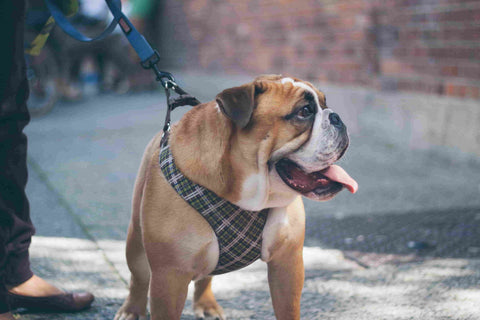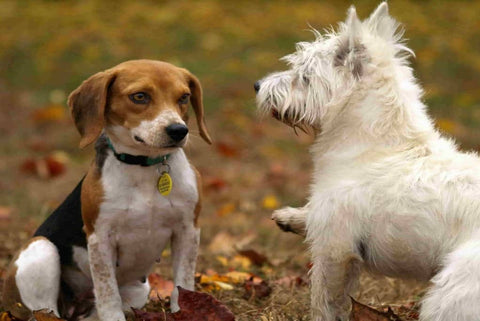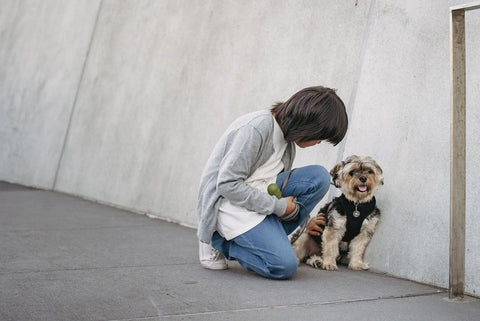How to Choose the Right No-Pull Harness for Medium Dogs
Some of the most common medium dog breeds include the bulldog, Border collie, poodle, beagle, and Labrador retriever. At Pet&Cuddle, we recommend that if you have a medium-sized dog, you consider using a no-pull harness for walking and training, as well as other daily activities.
A no-pull dog harness will simplify walking and mean more comfort and happiness for you and your dog.
While we believe there is no better walking and training tool than a harness, it can get a bit tricky to compare all the many options and find the right one for you. Getting the right style and fit are essential for functionality and safety. With that in mind, we created the following guide that explains how you can get the ideal no-pull harness for your medium dog.
We really wanted to provide all of our expertise in a guide that not just helps you choose the best no-pull harness for your medium dog but also highlights the many benefits of this piece of pet equipment.
Essential Features for Choosing a No-Pull Harness for Medium Dogs
We recently covered what a no-pull harness is, but before looking at how to choose the right one for a medium dog, we’ll recap.
- A no-pull dog harness helps reduce the frustration you might feel if your dog is constantly dragging you on walks.
- With a no-pull harness, you’re going to get more control, and your dog’s going to simultaneously learn the skills to walk correctly.
- A no-pull harness will fasten at the chest and behind your dog’s front legs usually and will have a front clip. The front clip is where the leash goes. The location of this clip is what differentiates the harness as no-pull, as opposed to having a clip at the back.
- When you hook a leash to the front clip, your dog has to stay by your side if he wants to move forward.
- If your dog does pull, the leash then goes to the side. That gently guides your dog back to you. With just some gentle pressure you can indicate to your dog to come back to you.
Choosing the right no-pull harness comes down to the following features:
Material Quality
If your dog is wearing something and seems uncomfortable, then he’s not going to learn to walk the right way. When you’re choosing a harness, evaluate how the material will feel against your dog’s skin. Does it feel soft? If so, that’s best.
Also, as far as the D-ring that the leash attaches to, choose metal when possible for longevity.
Adjustability
We’re going to talk more about getting the perfect fit for a harness below, but with that comes the importance of adjustability. Even when you measure for fit, if you choose a no-pull harness that’s adjustable, you’re going to get an even better and more customized fit. A harness shouldn’t be too tight or too loose. Otherwise, it could be ineffective or even worse, dangerous.
Ease Of Use
When it comes to how to put on a no-pull dog harness and how to use a no-pull dog harness, simplicity is key. You want a design that prioritizes ease of use for you. This will make you more inclined to go on walks and your dog as well. If you choose a harness that’s too hard to put on, your dog may start to avoid it.
Lightweight
A well-designed, user-friendly harness will be lightweight enough to grab as you’re heading out the door or to throw in your bag
Safety
When comparing a no-pull harness to a collar, the harness is inherently safer. You’re not putting too much pressure on any one point of your dog’s body, and especially not his neck and trachea. You can train your dog without the risk of injuring him.
Pro Features to Look for in a Dog Harness
If you want to go beyond the basics, you can also consider the features below:
- Multiple clips: What separates a no-pull harness from other types is the location of a front clip. That doesn’t mean you have to be restricted to just using a front clip, however. There are harnesses that are dual-clip, with one in the front for training and control and one in the back that you can use once your dog has learned not to pull. A dual-clip harness is a good investment because it’s versatile and you can use it no matter the situation.
- Reflective straps: Do you prefer walking in the evenings once the day is over, or maybe going out in the early mornings? If so, don’t forget reflective straps as you’re choosing the best no-pull harness.
- Soft and flexible materials: When your dog is comfortable, walks are going to be easier, more enjoyable, and your dog will be more receptive to training. Choose a harness with cushioning made of soft materials.
How to Use a No-Pull Dog Harness for Medium Dogs
When you first start to use a no-pull dog harness, even when you’ve taken the time and selected a great piece of equipment, it’s new to your dog. You need to get your dog used to it.
- First, when you’re using the harness initially, consider adjusting the straps as much as you can before you put it on your dog.
- You might also want to let your dog sniff and get used to the harness before actually putting it on.
- You may have to do some further adjusting once it’s on, and if so, give your dog praise or treats while you do this.
- When you first start using the harness, do short walks so your dog will start to get accustomed to how it feels to wear it.
Before you can do anything above, such as figuring out how to put on a no-pull dog harness or how to use a no-pull dog harness, the fit has to be right.
Get the Right Size by Measuring Your DogToo often, we hear from customers that they relied on weight alone when trying to select a no-pull harness. This doesn’t work because even if two dogs are the same weight, they can have different dimensions and builds. While weight might be one metric you consider when shopping for harnesses, it shouldn’t be the only one.
Take the following measurements for the correct fit:
- Step 1: The first measurement you want to get is at the base of your dog’s neck, which is the widest point. This is not where a collar would sit. A collar sits higher. You’ll need to use a tape measure or something soft to get this measurement and the others below.
- Step 2: Now that you have the neck measurement at the widest point, move onto measuring your dog’s chest. This measurement should be taken at the broadest point, right behind his armpits. You should wrap your tape measure around the chest and then bring it to meet at his back. Don’t pull it too tight, or you risk getting a harness that’s too small.
- Step 3: Your next measurement is your dog’s length. Take your tape measure in a straight line from right behind the right leg to the point just behind the back leg.
- Step 4: Get a belly girth measurement, which you should measure just about an inch in front of the back legs.
- Step 5: Go to Pet&Cuddle’s website and use our size chart to compare your measurements.
Steps for Achieving a Proper Fit
There are a few additional notes we always like to tell customers when they’re choosing a harness for a medium dog.
- Tip #1: If you take your dog’s measurements and find that they’re falling between two sizes, go up.
- Tip #2: Once you get your medium dog’s harness and you’ve adjusted it, there’s a simple fit test. Take any two of your fingers and slide them under any of the straps. Your fingers should go under, and the fit should be snug but not too tight.
- Tip #3: To make sure the harness isn’t too big, attempt to pull it over your dog’s head. If you can, make some more adjustments.
What Are the Benefits of Using No-Pull Harnesses for Medium Dogs?
If you’re using a traditional collar, you’re not able to take advantage of the many benefits of a no-pull harness. When we’re asked by customers what we recommend, we always say a no-pull harness because its design makes it the better choice across the board, including for medium dogs, dogs that pull, and dogs that are otherwise difficult to handle when you’re walking.
- ·Functionality: Walking your dog needs to be enjoyable. It’s an important part of your dog’s physical and mental health to get enough exercise. The more functional your equipment is, the better trained your dog gets, and the more willing both of you are going to be to go on walks. A harness lets you walk with control over your dog’s movements and your dog can learn how to stay with you appropriately.
- Training: Learning how to walk on a leash is a fundamental skill your dog needs. A harness with a no-pull design is the best way for your dog to learn this. The design of a harness with a front clip leash attachment provides gentle reinforcement for walking technique without being painful or potentially harmful to your dog.
- Safety: A collar is a possible danger to your dog, especially if he’s prone to pulling. It puts so much pressure on his throat and trachea whereas a harness evenly, safely and comfortably disperses it.
- Control: A medium dog can be tough to manage on a regular collar. That can make you worried about what might happen if there are other animals, people, or cars nearby. No-pull harnesses give you control so you’re not constantly worrying on your walks.
Can I Use a No-Pull Harness and Retractable Leash Together?
A retractable leash is in our opinion, much better than a standard leash. A retractable leash gives your dog more freedom, they can be used for training and they’re easier to use. Can you pair it with a no-pull harness?
Yes, you can use a no-pull harness and retractable leash together, and the combination is good for training.
You do need to make sure if you’re using a no-pull harness and retractable leash together that you’re not letting the leash generate tension on the front clip. That makes your dog feel like he’s pulling but he’s not, and that can impede training. Instead, use a fixed-length on the leash which then generates a squeeze and lift mechanism that stops pulling.
Should You Really Use a Harness for Medium Dogs?
At Pet&Cuddle, we love what we do, which is to help people like you find the dog equipment solutions that make your life better and easier. We absolutely recommend using a harness for your medium dog. You’ll have control, the ability to train your dog safely and you can use a harness to do a variety of activities including walking, hiking and running.
We’ve put together a high-quality no-pull harness collection for medium dogs, using our experience to get each detail just right. We encourage you to take a look at our harnesses here.
Questions About Dog Harnesses
In talking with our customers and helping them choose dog harnesses and other equipment, we’re often able to pass what we hear most frequently to you. With that in mind, below are briefly some answers to the questions our team gets most often.
Is It Safe to Use No-Pull Harnesses for Medium Dogs?
Not only is it overall safe to use no-pull harnesses for medium dogs, but it’s significantly safer than using a collar. Take your time to get the right size, and you’ll enjoy a reduced risk of injury and a comfortable experience for both you and your dog.
How Tight Should a No-Pull Harness for Medium Dogs Be?
The goal of fitting a no-pull harness on your medium dog is to ensure that it’s snug enough to work and prevent escape but not so tight that it’s uncomfortable. When a harness is too tight, it can irritate the skin and restrict movement.
With that in mind, the two-finger trick we talked about above is a good guide for you. If you slip your finger under a strap and it feels uncomfortably tight, readjust.
Can a Dog Wear a Harness All the Time?
There’s no reason to keep a harness on your dog all the time. It’s not an accessory but instead is a functional piece of equipment. Leaving a harness on all the time can be uncomfortable and cause circulation and other possible health issues. Take it off when you get home from your walks.
What’s Better: Harnesses or Collars for Medium Dogs?
Hands-down a harness is better for a medium dog or a dog of any size compared to a collar. Harnesses, as long as they fit well and are well-made are comfortable, safe, and work for training and walking.
Get Your Best No-Pull Harness for Medium Dogs On Pet&Cuddle
Ready to shop and enjoy the benefits of a no-pull harness for medium dogs? Great, head over to our website at Pet&Cuddle and browse our selection of the safest and most well-made harnesses for medium dogs as well as small and big dogs.
If you aren’t sure where to start, our team of dog lovers can help you find one that’s just right. We’re constantly updating our collections to ensure we offer you and your dog the best of the best.




